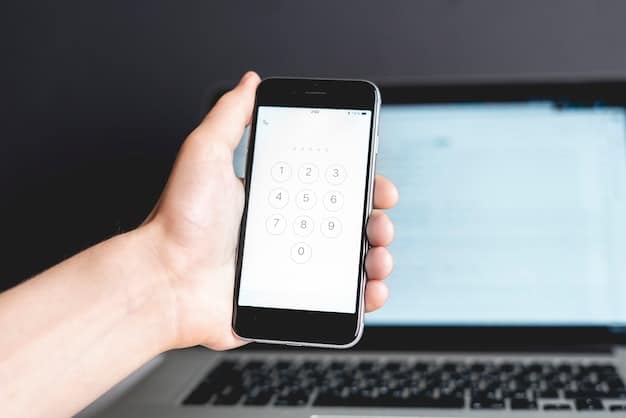US Remote Team Cybersecurity: Updated Protocols for 2025

Protecting sensitive data of US remote teams in 2025 requires updated cybersecurity protocols encompassing enhanced authentication, robust encryption, comprehensive training, and proactive threat monitoring.
The rise of remote work in the US has brought undeniable advantages, but it has also expanded the attack surface for cyber threats. Securing sensitive data requires a comprehensive understanding of the challenges and the implementation of updated cybersecurity protocols. Let’s explore how to bolster US Remote Team Cybersecurity: Protecting Sensitive Data with Updated Protocols in 2025.
Understanding the Evolving Cybersecurity Landscape for US Remote Teams
The cybersecurity landscape is constantly evolving, and remote teams present unique challenges. Understanding these challenges is the first step in developing a robust security posture. With the increasing sophistication of cyberattacks, US Remote Team Cybersecurity: Protecting Sensitive Data with Updated Protocols in 2025 must be proactive and adaptive.
Remote work introduces vulnerabilities that traditional office environments don’t face. Securing home networks, personal devices, and cloud-based collaboration tools creates a complex web of potential entry points for attackers. It’s essential to understand these vulnerabilities to develop targeted solutions.
Common Cybersecurity Threats Targeting Remote Teams
Remote teams are increasingly vulnerable to a range of cybersecurity threats. Recognizing these threats and their potential impact is crucial for effective protection. Here are some of the most prevalent threats:
- Phishing Attacks: Cybercriminals often target remote workers with sophisticated phishing emails that trick them into revealing sensitive information.
- Malware Infections: Remote devices are more susceptible to malware infections, especially if they are not adequately protected with updated antivirus software.
- Unsecured Home Networks: Home networks often lack the robust security measures found in corporate networks, making them easy targets for attackers.
- Data Breaches: Remote workers handling sensitive data outside of a secure office environment face an increased risk of data breaches.
Addressing these threats requires a multi-faceted approach that includes training, technology, and policy. Remote teams need to be vigilant and equipped with the tools to detect and respond to potential security incidents.
In conclusion, understanding the cybersecurity landscape is paramount for remote teams. By recognizing the threats and vulnerabilities inherent in remote work, organizations can implement proactive measures to protect sensitive data in 2025.
Implementing Multi-Factor Authentication (MFA) for Enhanced Security
Multi-Factor Authentication (MFA) adds an extra layer of security beyond a simple password. By requiring users to verify their identity through multiple channels, MFA significantly reduces the risk of unauthorized access. Implementing MFA is crucial for US Remote Team Cybersecurity: Protecting Sensitive Data with Updated Protocols in 2025.
MFA can take many forms, including one-time codes sent to mobile devices, biometric authentication, or hardware security keys. Regardless of the method, MFA makes it much harder for attackers to gain access to sensitive data even if they manage to steal a password.

For US Remote Team Cybersecurity: Protecting Sensitive Data with Updated Protocols in 2025, it is important to identify all the tools that collect data, and make sure that MFA is properly implemented in at least one of them, especially the most significant ones.
Benefits of Multi-Factor Authentication
Implementing MFA offers numerous benefits that greatly enhance the security of remote teams. These benefits include:
- Reduced Risk of Account Takeovers: MFA makes it significantly harder for cybercriminals to take over user accounts, even if they obtain passwords through phishing or other means.
- Protection Against Phishing Attacks: Even if a user falls victim to a phishing attack and reveals their password, MFA can prevent the attacker from accessing their account.
- Compliance with Regulations: Many regulations and industry standards require MFA for protecting sensitive data, helping organizations meet compliance requirements.
- Improved User Confidence: MFA provides users with greater confidence in the security of their accounts and data, fostering a culture of security awareness.
MFA is no longer a luxury; it is a necessity for any organization that takes cybersecurity seriously. By implementing MFA across all critical systems and applications, remote teams can significantly reduce their risk of falling victim to cyberattacks.
In conclusion, implementing MFA is a fundamental step in enhancing the security of remote teams. By adding an extra layer of authentication, MFA significantly reduces the risk of unauthorized access and account takeovers.
Securing Communication Channels with Encryption
Encryption is the process of converting data into an unreadable format, protecting it from unauthorized access. Securing communication channels with encryption is vital for US Remote Team Cybersecurity: Protecting Sensitive Data with Updated Protocols in 2025. Encrypted channels ensure that sensitive information remains confidential, even if intercepted.
End-to-end encryption, where data is encrypted on the sender’s device and decrypted only on the recipient’s device, provides the highest level of security. This prevents intermediaries, including the service provider, from accessing the data.
Best Practices for Encrypting Communication Channels
To effectively secure communication channels with encryption, organizations should follow these best practices:
- Use End-to-End Encrypted Messaging Apps: Implement messaging apps that offer end-to-end encryption for all communications, such as Signal or WhatsApp.
- Encrypt Email Communications: Use email encryption tools or services, such as PGP or S/MIME, to encrypt sensitive email communications.
- Secure Video Conferencing: Choose video conferencing platforms that offer encryption and require strong passwords for meetings to prevent unauthorized access.
- Encrypt File Sharing: Use encrypted file sharing services or tools to securely share sensitive files with remote team members.
Encrypting communication channels is a critical step in safeguarding sensitive data and maintaining confidentiality. By implementing encryption across all communication channels, remote teams can significantly reduce the risk of data breaches and unauthorized access.
In conclusion, securing communication channels with encryption is essential for protecting sensitive data. By implementing end-to-end encryption and following best practices, remote teams can ensure that their communications remain confidential and secure.
Conducting Regular Cybersecurity Training for Remote Workers
Human error is a significant factor in many cybersecurity breaches. Regular cybersecurity training for remote workers is essential to raise awareness and equip them with the skills to identify and respond to threats effectively. Prioritizing training helps achieve US Remote Team Cybersecurity: Protecting Sensitive Data with Updated Protocols in 2025.
Training should cover a wide range of topics, including phishing awareness, password security, safe browsing habits, and data protection policies. It should also be ongoing, with regular updates to address new threats and vulnerabilities.
Key Topics to Include in Cybersecurity Training
Here’s a list.
- Phishing email awareness
- Password security
- Social engineering awareness
- Data security awareness
Including all of these topics guarantees better US Remote Team Cybersecurity: Protecting Sensitive Data with Updated Protocols in 2025, as risks are diminished.

Cybersecurity training should not be a one-time event but an ongoing process that reinforces key concepts and addresses emerging threats. Regular training sessions, quizzes, and simulated phishing attacks can help keep remote workers engaged and vigilant.
In conclusion, conducting regular cybersecurity training is critical for empowering remote workers to identify and respond to cyber threats. By providing ongoing training and reinforcing key concepts, organizations can significantly reduce their risk of falling victim to human error.
Implementing a Robust Endpoint Security Strategy
Endpoint security focuses on protecting individual devices, such as laptops and smartphones, from cyber threats. Having a robust endpoint security strategy is crucial for US Remote Team Cybersecurity: Protecting Sensitive Data with Updated Protocols in 2025. Remote workers often use their devices outside of the traditional office environment, making them more vulnerable to malware and other attacks.
Endpoint security includes a range of tools and technologies, such as antivirus software, firewalls, intrusion detection systems, and endpoint detection and response (EDR) solutions. These tools work together to prevent, detect, and respond to cyber threats on individual devices.
Essential Components of an Endpoint Security Strategy
An effective endpoint security strategy should include the following components:
- Antivirus Software: Protects devices from malware infections by scanning files and programs for known threats.
- Firewalls: Blocks unauthorized access to devices by monitoring network traffic and filtering out malicious connections.
- Intrusion Detection Systems (IDS): Detects suspicious activity on devices and alerts security personnel to potential threats.
- Endpoint Detection and Response (EDR): Provides advanced threat detection and response capabilities, including behavioral analysis and automated remediation.
Implementing a robust endpoint security strategy is essential for protecting remote devices from cyber threats. By deploying the right tools and technologies, organizations can significantly reduce their risk of falling victim to malware and other attacks.
In conclusion, endpoint security is a critical component of any cybersecurity strategy for remote teams. By implementing a robust endpoint security strategy, organizations can protect individual devices from cyber threats and minimize the risk of data breaches.
Establishing Clear Data Governance Policies and Procedures
Data governance refers to the policies and procedures that govern how data is managed, used, and protected. Establishing clear data governance policies and procedures is vital for US Remote Team Cybersecurity: Protecting Sensitive Data with Updated Protocols in 2025. These policies ensure that sensitive data is handled properly and in compliance with regulations.
Data governance policies should define who has access to what data, how data is used, and how data is protected. They should also address issues such as data retention, data disposal, and data breach response.
Key Elements of Data Governance Policies
Effective data governance policies should include the following elements:
- Data Classification: Categorizing data based on its sensitivity and importance to the organization.
- Access Controls: Defining who has access to what data and implementing measures to restrict unauthorized access.
- Data Encryption: Encrypting sensitive data to protect it from unauthorized access during storage and transmission.
- Data Retention: Establishing policies for how long data should be retained and securely disposed of when no longer needed.
Data governance policies should be clear, comprehensive, and regularly reviewed to ensure they remain effective. They should also be communicated to all remote workers and enforced consistently.
In conclusion, establishing clear data governance policies and procedures is essential for protecting sensitive data and ensuring compliance with regulations. By implementing effective data governance policies, organizations can minimize the risk of data breaches and unauthorized access.
| Key Aspect | Brief Description |
|---|---|
| 🔒 MFA Implementation | Enhance security with multi-factor authentication across platforms. |
| 🛡️ Encryption Protocols | Secure communications and file sharing with end-to-end encryption. |
| 👩💻 Training Programs | Ensure regular cybersecurity training for all remote team members. |
| 📊 Data Policies | Establish clear and enforced data governance policies. |
[Frequently Asked Questions]
▼
The biggest risk is the combination of human error and unsecured home networks, which can lead to data breaches and malware infections.
▼
Cybersecurity training should be ongoing, with regular updates and refreshers to address new threats and vulnerabilities.
▼
It adds an extra layer of security against unauthorized access, even if passwords are compromised through phishing or other means.
▼
Endpoint security protects individual devices from cyber threats, which is critical for remote teams using their own devices outside the office.
▼
These policies should define data access, usage, protection, retention, and disposal, ensuring compliance and minimizing data breach risks.
Conclusion
In conclusion, protecting sensitive data for US remote teams in 2025 requires a proactive and comprehensive approach to cybersecurity. By implementing MFA, encrypting communication channels, conducting regular cybersecurity training, deploying a robust endpoint security strategy, and establishing clear data governance policies, organizations can significantly reduce their risk of falling victim to cyber threats and ensure the security of their remote workforce.





